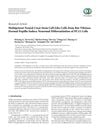TLDR HGF-modified hair follicle stem cells help brain recovery after injury in rats.
The study demonstrates that hepatocyte growth factor (HGF)-modified hair follicle stem cells (HFSCs) significantly improve neurological outcomes in rats with cerebral ischemia/reperfusion (I/R) injury. Using 120 rats divided into various groups, the research found that HGF-modified HFSCs reduced brain infarct volume, decreased neuron apoptosis, and improved neurological function compared to unmodified HFSCs and saline treatments. The treatment also inhibited microglia activation, protected blood-brain barrier integrity, and promoted angiogenesis. These findings suggest that HGF-modified HFSCs offer a promising approach for enhancing recovery after ischemic stroke by mitigating inflammation and supporting neurological recovery.
11 citations
,
September 2019 in “The journal of investigative dermatology/Journal of investigative dermatology” A specific group of skin stem cells was found to help maintain hair follicle cells.
 10 citations
,
January 2014 in “BioMed research international”
10 citations
,
January 2014 in “BioMed research international” Rat whisker cells can help turn other cells into nerve cells and might be used to treat brain injuries or diseases.
419 citations
,
March 2005 in “Proceedings of the National Academy of Sciences” Hair-follicle stem cells can become neurons.
 March 2025 in “Anatomy & Cell Biology”
March 2025 in “Anatomy & Cell Biology” Hair follicle stem cell secretions may help protect brain cells and improve stroke recovery.
 27 citations
,
January 2020 in “Experimental Dermatology”
27 citations
,
January 2020 in “Experimental Dermatology” Immune cells affect hair growth and could lead to new hair loss treatments.
 245 citations
,
January 2018 in “Bone Research”
245 citations
,
January 2018 in “Bone Research” TGF-β is crucial for tissue repair and can cause diseases if not properly regulated.
 April 2024 in “The Journal of experimental medicine/The journal of experimental medicine”
April 2024 in “The Journal of experimental medicine/The journal of experimental medicine” Treg cells help repair and regenerate tissues by interacting with local cells.
 2 citations
,
January 2023 in “International journal of biological sciences”
2 citations
,
January 2023 in “International journal of biological sciences” Gray hair can potentially be reversed, leading to new treatments.





